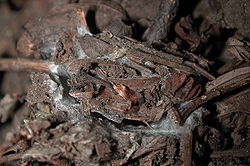- Wafer trapdoor spider
-
Wafer trapdoor spiders 
Aptostichus sp. Scientific classification Kingdom: Animalia Phylum: Arthropoda Class: Arachnida Order: Araneae Suborder: Mygalomorphae Infraorder: Fornicephalae Superfamily: Cyrtauchenioidea Family: Cyrtaucheniidae
Simon, 1892Genera Aptostichus
Myrmekiaphila
Promyrmekiaphila
others, see textDiversity 18 genera, 126 species 
The wafer trapdoor spiders (superfamily Cyrtauchenioidea,[1] family Cyrtaucheniidae) are a widespread family of spiders that lack the thorn-like spines on tarsi and metatarsi I and II (the two outermost leg segments) found in true trapdoor spiders (Ctenizidae).
Contents
Biology
Many, but not all, make wafer-like doors to their burrows, while others build the cork-like doors found commonly in the true trapdoor spiders. The biology of nearly all the species is poorly known.
The monotypic Angka hexops has only six eyes, with the posterior median eyes missing. It is up to 15 mm long in both sexes.[2]
Distribution
The family is well represented in the United States, Mexico, South America, and Africa. Common U.S. genera include Myrmekiaphila, Aptosticus and Promyrmekiaphila. A currently undescribed genus in the western United States may hold an altitude record for the family, being found up to over 11,000 feet (3,300 meters). The genus Anemesia is found only in Central Asia, and Cyrtauchenius reaches from Algeria north to Italy, with one species found in the USA. Angka is endemic to the cloud forest of Doi Inthanon, Thailand.
Genera
The categorization into subfamilies follows Raven (1985)
- Aporoptychinae Simon, 1889
- Cyrtaucheniinae Simon, 1892
-
- Cyrtauchenius Thorell, 1869 — Mediterranean
- Euctenizinae Raven, 1985
-
- Apomastus Bond & Opell, 2002 — USA
- Aptostichus Simon, 1891 — USA
- Entychides Simon, 1888 — USA, Mexico
- Eucteniza Ausserer, 1875 — USA, Mexico
- Homostola Simon, 1892 — South Africa
- Myrmekiaphila Atkinson, 1886 — USA
- Neoapachella Bond & Opell, 2002 — USA
- Promyrmekiaphila Schenkel, 1950 — USA
-
- Anemesia Pocock, 1895 — Turkmenistan, Tajikistan, Afghanistan
- Angka Raven & Schwendinger, 1995 — Thailand
See also
- List of Cyrtaucheniidae species
- Spider families
Footnotes
References
- Raven, Robert J. (1985): The spider Infraorder Mygalomorphae (Araneae): cladistics and systematics. Bulletin of the American Museum of Natural History 182: 1-180.
- Murphy, Frances & Murphy, John (2000): An Introduction to the Spiders of South East Asia. Malaysian Nature Society, Kuala Lumpur.
- Platnick, Norman I. (2008): The world spider catalog, version 8.5. American Museum of Natural History.
External links
- Platnick, Norman I. (2008): The world spider catalog, version 8.5. American Museum of Natural History: Cyrtaucheniidae
Categories:- Cyrtaucheniidae
Wikimedia Foundation. 2010.


